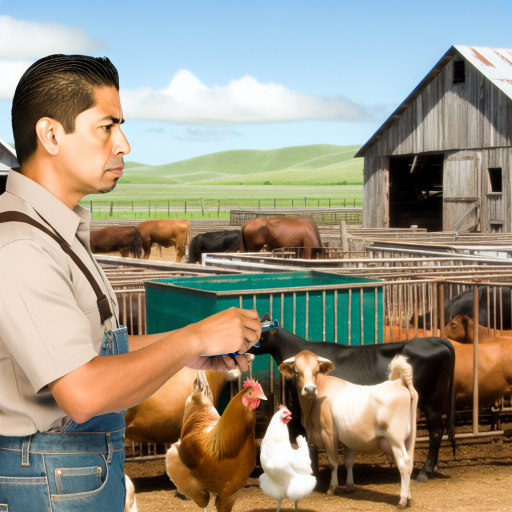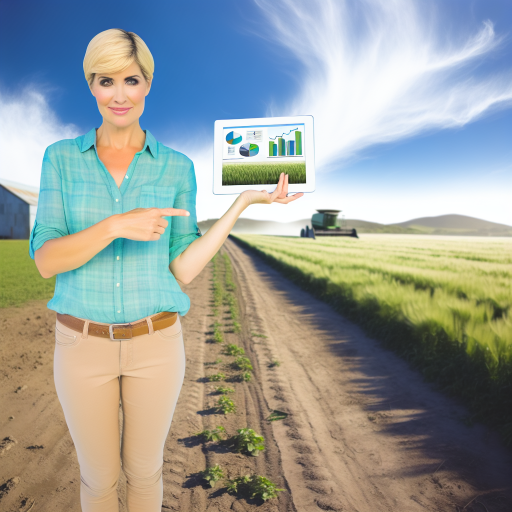Introduction:
Agricultural economics is vital in understanding the financial aspects of farming activities.
It involves analyzing production, consumption, and distribution of agricultural goods.
Historical perspectives reveal how agriculture has evolved over centuries.
From subsistence farming to commercial agriculture, the field has witnessed significant changes.
The Origins of Agricultural Economics
The origins of agricultural economics trace back to early civilizations like Mesopotamia and Ancient Egypt.
These ancient societies practiced rudimentary forms of agriculture.
This laid the foundation for economic principles.
In Mesopotamia, farmers used advanced irrigation techniques to maximize crop yields.
They managed water resources efficiently.
Similarly, in Ancient Egypt, the development of the Nile Valley’s agriculture system showcased the importance of economic planning.
This also highlighted management practices.
Evolution from Traditional Farming Practices
As societies grew more complex, the need for organized agricultural production became paramount.
With the Industrial Revolution, agricultural economics shifted towards mechanization.
This also included specialization and trade.
The evolution of agricultural economics stems from integrating traditional farming practices with modern economic theories.
From small-scale farms to large agribusinesses, the field continues to adapt.
This adaptation addresses changing global demands and challenges.
Development of Agricultural Economics
The field emerged as a response to the challenges faced by farmers in increasing agricultural productivity while maintaining profitability.
Agricultural economics aimed to apply economic principles to farming practices.
This helped farmers make informed decisions based on cost-benefit analysis and market trends.
Transform Your Career Today
Unlock a personalized career strategy that drives real results. Get tailored advice and a roadmap designed just for you.
Start NowThe discipline focused on studying the allocation of resources in agriculture.
This includes land, labor, and capital to optimize production and efficiency.
Key Figures and Contributions
- John Stuart Mill, a prominent economist, made significant contributions to agricultural economics by emphasizing the role of land in economic development.
- Alfred Marshall, known for his work on supply and demand theory, applied economic principles to agriculture.
- Stanley Jevons, a pioneer in mathematical economics, applied mathematical models to agricultural production.
- Theodore Schultz, a Nobel laureate, highlighted the importance of human capital in agricultural development.
- John Maynard Keynes also made contributions to agricultural economics by analyzing the impact of government policies on agricultural markets.
The birth of agricultural economics as a discipline in the 19th century marked a significant milestone in understanding and improving agricultural practices.
Key figures and their contributions played a crucial role in shaping the field.
They laid the foundation for modern agricultural economics.
You Might Also Like: Food Science and the Art of Fermentation
Impact of the Great Depression on Agriculture
During the Great Depression, agriculture was hit hard with plummeting prices and reduced demand for farm products.
Farmers faced significant challenges as they struggled to make ends meet during this tumultuous period.
Many agricultural families lost their livelihoods, leading to widespread poverty and hunger in rural communities.
The impact of the Great Depression on agriculture was severe, with many farmers unable to sustain their operations.
As a result, farm incomes decreased drastically, forcing many farmers into bankruptcy and foreclosure.
The sharp decline in agricultural production further exacerbated the economic hardships faced by farming communities.
Government intervention played a crucial role in providing relief to struggling farmers during the Great Depression.
One of the key policies implemented during this time was the Agricultural Adjustment Act of 1933.
The AAA aimed to raise farm prices by reducing agricultural production through government-mandated quotas.
Farmers who participated in the AAA were paid subsidies to reduce their production levels and stabilize farm prices.
Another significant government intervention was the creation of the Farm Security Administration in 1937.
The FSA provided loans and assistance to farmers to help them restructure their debts and stay afloat during the crisis.
The government also established programs such as the Civilian Conservation Corps, which employed young men to work on conservation projects on farmlands.
These government programs helped alleviate some of the economic hardships faced by farmers during the Great Depression.
Transform Your Career Today
Unlock a personalized career strategy that drives real results. Get tailored advice and a roadmap designed just for you.
Start NowDespite these efforts, the agricultural sector continued to struggle throughout the 1930s, with many farmers unable to recover fully.
The Great Depression had a profound impact on agriculture and agricultural economics, leading to long-lasting changes in the industry.
Explore Further: Soil Health: Practices and Policies for Sustainability
The Post-World War II Era in Agricultural Economics
The post-World War II era marked a significant shift in agricultural economics.
Technological advancements played a crucial role in increasing agricultural productivity.
Agricultural economists focused on improving efficiency and sustainability in farming practices.
Through research and innovation, new methods and technologies were introduced to boost yield.
The Green Revolution, which began in the 1940s, was a game-changer in agriculture.
It aimed to increase food production and alleviate hunger in developing countries.
New high-yielding varieties of crops, fertilizers, and pesticides were introduced during this period.
The impact of the Green Revolution on agricultural economics was profound.
It led to increased crop yields, improved food security, and economic growth.
Farming practices became more commercialized and mechanized, leading to higher productivity.
Developing countries saw a significant reduction in hunger and poverty due to increased agricultural output.
The Green Revolution also brought about changes in land use patterns and crop diversification.
Agricultural economics played a crucial role in analyzing and studying the impacts of these changes.
Farmers were able to adopt modern agricultural practices and technologies, leading to improved livelihoods.
Government policies and investments in agriculture were influenced by the principles of agricultural economics.
Global trade in agricultural products also saw a boost due to increased production and exports.
The role of agricultural economists was crucial in ensuring sustainability and long-term growth.
Transform Your Career Today
Unlock a personalized career strategy that drives real results. Get tailored advice and a roadmap designed just for you.
Start NowAnalyzing trends in agricultural markets and prices helped farmers make informed decisions.
The post-World War II era witnessed a transformation in the agricultural sector.
The Green Revolution, coupled with advancements in agricultural economics, revolutionized farming practices.
Agricultural economists continue to play a vital role in shaping policies and practices in the sector.
Gain More Insights: How Food Scientists Conduct Food Safety Testing

Modern trends in agricultural economics:
- Explore current trends and challenges in agricultural economics
- Discuss the role of technology in shaping the field
- Examine the impact of globalization on agricultural economics
In recent years, agricultural economics has undergone significant transformations due to various modern trends.
These trends have played a crucial role in shaping the field and presenting new challenges and opportunities for researchers, policymakers, and practitioners in the agricultural sector.
Current Trends and Challenges
One of the key trends in agricultural economics today is the increasing focus on sustainability.
With growing concerns about climate change and environmental degradation, there is a strong emphasis on developing sustainable agricultural practices.
These practices minimize the impact on the environment while meeting the increasing demand for food.
Another major trend is the rise of digital technologies in agriculture.
The advent of precision agriculture, big data analytics, and artificial intelligence has revolutionized farming practices.
These innovations enable farmers to make data-driven decisions and optimize their resource use.
However, this trend also poses challenges related to data privacy and cybersecurity.
Furthermore, the changing demographics of the agricultural workforce present a significant challenge for the industry.
As younger generations are less inclined to pursue careers in agriculture, there is a pressing need to attract and retain talent in the sector.
Role of Technology
Technology plays a pivotal role in shaping modern agricultural economics.
Innovations such as drones, sensors, and automated machinery have enhanced the efficiency and productivity of farming operations.
This has led to improved crop yields and reduced input costs.
Moreover, digital platforms and e-commerce have facilitated direct marketing channels for farmers.
Transform Your Career Today
Unlock a personalized career strategy that drives real results. Get tailored advice and a roadmap designed just for you.
Start NowThis enables them to reach a wider market and obtain better prices for their produce.
The direct-to-consumer approach has the potential to revolutionize the agricultural supply chain.
It does this by bypassing traditional intermediaries and ensuring fairer returns for farmers.
Additionally, the emergence of blockchain technology has the potential to transform the way agricultural transactions are conducted.
This technology provides greater transparency and traceability throughout the supply chain.
This can help address issues related to food safety, quality assurance, and counterfeit products.
Impact of Globalization
Globalization has had a profound impact on agricultural economics.
It has opened up new markets and opportunities for farmers to export their products worldwide.
However, it has also exposed them to increased competition from international producers.
This can lead to price volatility and market fluctuations.
Moreover, globalization has facilitated the transfer of knowledge and best practices across borders.
This enables farmers to adopt innovative techniques and technologies from other countries.
This knowledge exchange has the potential to enhance productivity and sustainability in agriculture.
It benefits both producers and consumers.
However, globalization has also raised concerns about food security and sovereignty.
The dependence on global markets for food supply can leave countries vulnerable to disruptions.
This underscores the importance of promoting self-sufficiency and resilience in agricultural systems.
These strategies help mitigate risks associated with global market dynamics.
Learn More: Common Tools Used by Seed Technologists
Environmental Concerns in Agriculture
Environmental concerns have become increasingly important in agricultural economics in recent years.
Transform Your Career Today
Unlock a personalized career strategy that drives real results. Get tailored advice and a roadmap designed just for you.
Start NowConcerns such as climate change, deforestation, and soil degradation are affecting agricultural productivity.
Farmers and policymakers are recognizing the need to shift towards sustainable agriculture practices.
Sustainable agriculture focuses on enhancing environmental quality while maintaining productivity and profitability.
One of the key principles of sustainable agriculture is soil conservation to prevent erosion.
Integrating livestock and crop production can help improve soil fertility and reduce the need for synthetic inputs.
Crop diversification and crop rotation are also important practices in sustainable agriculture.
By rotating crops, farmers can prevent soil nutrient depletion and control pests naturally.
Reducing the use of chemical fertilizers and pesticides can improve water quality and biodiversity on farms.
Agroforestry is another sustainable agriculture practice that combines trees and crops to benefit the ecosystem.
These practices not only help protect the environment but also ensure the long-term viability of agricultural production.
The demand for sustainably produced food is growing as consumers become more conscious of environmental issues.
Adopting sustainable agriculture practices can also help farmers reduce production costs and increase resilience to climate change.
The shift towards sustainable agriculture is essential for addressing environmental concerns and ensuring the future of agriculture.
Exploring Agricultural Economics
We have explored the historical perspectives and evolution of agricultural economics.
This exploration has highlighted key events, theories, and practices shaping the field.
Understanding this rich history is crucial for informed decisions in the future.
Additional Resources
Analysis of Previous Farm Bills – USDA ERS
Agriculture Overview: Development news, research, data | World Bank
[E-Books for Sale]
The Big Book of 500 High-Paying Jobs in America: Unlock Your Earning Potential
$19.99 • 500 High-Paying Jobs • 330 pages
Explore 500 high-paying jobs in America and learn how to boost your career, earn more, and achieve success!
See All 500 High-Paying Jobs of this E-Book
1001 Professions Without a Degree: High-Paying American Jobs You Can Start Now
$19.99 • 1001 Professions Without a Degree • 174 pages
Discover 1001 high-paying jobs without a degree! Unlock career tips, skills, and success strategies for just $19.99!




